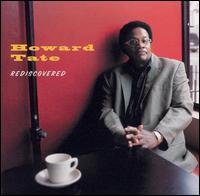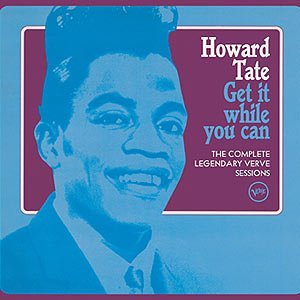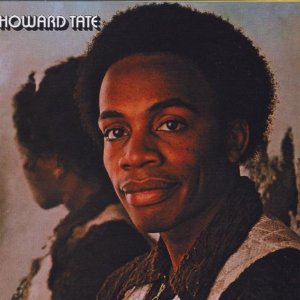INTRODUCTION
I was surprised and very saddened to learn that the great soul singer Howard Tate had died 12.2.2011 at age 72, reportedly from complications of multiple myeloma and leukemia. His Verve debut album (especially in its killer mono version) has been a personal favorite of mine ever since I first heard it, a few years after the original 1967 release.
After decades in complete obscurity, Howard made a stunning comeback in 2001 and thereafter enjoyed a career revival that brought him more attention — and, one hopes, financial reward — than he’d ever received during his first go-round. He toured the world and recorded four more albums, beginning with Howard Tate Rediscovered (Private Music/RCA, 2003). This disc reunited the singer with his original studio Svengali, songwriter/producer/arranger Jerry Ragovoy (who died 7.13.2011), and I wish I could say that the results were even close to their Sixties glory days. Nonetheless, I was honored to contribute liner notes for Rediscovered and have posted the full unedited version here. (A.S.)
• • • • •
On the night of July 21, 2001, in a subterranean Manhattan nightclub called The Village Underground, a packed house buzzed with anticipation. As the lights went down and the Uptown Horns band kicked off the first song of the set, a short, stout, nattily dressed man stepped to the microphone. And with the first notes of that first song, Howard Tate reclaimed his rightful place in American music.
 We looked at Howard and Howard looked at us, and it was hard to say who was the more shocked and surprised to see the other. Just a few short years before, neither would have guessed that this moment would ever come to pass. But he who once was lost, now was found. And we, who once were blind, now could see: That before us stood one of the greatest living soul singers—indeed, one of the greatest of all time.
We looked at Howard and Howard looked at us, and it was hard to say who was the more shocked and surprised to see the other. Just a few short years before, neither would have guessed that this moment would ever come to pass. But he who once was lost, now was found. And we, who once were blind, now could see: That before us stood one of the greatest living soul singers—indeed, one of the greatest of all time.
In the spring of 1967, a few months before his 28th birthday, Howard Tate released a self-titled debut album (later reissued as Get It While You Can) that became a revered classic of the Sixties soul era.
Born August 14, 1939 in the rural hamlet of Eberton, GA, Howard Tate had moved with his family to Macon and then Philadelphia, PA. His father preached in a Baptist church, and Howard sang with a youthful gospel group, the Bel-Aires, that later recorded a few unsuccessful r&b singles as the Gainors. When the group broke up, organist Bill Doggett recruited Howard as the vocalist for his popular combo.
Meanwhile, ex-Gainors Garnet Mimms and Sam Bell formed a new group called the Enchanters and in 1963 scored a breakthrough hit with “Cry Baby.” At No. 4, “Cry Baby” was the first “deep soul” record to crack the Top Ten (as well as a No. 1 R&B hit). It was, as author Robert Pruter later wrote, “a gospelized production so full of soul-saving, fire-and-brimstone ecstasies of the Black sanctified church that it singularly stood apart…Never before had the public heard anything so intense and so emotional on Top 40 radio.”

The 1995 CD reissue of Howard Tate's Verve debut, long out of print. Sealed copies are listed on Amazon.com for up to $200.
“Cry Baby” was co-written and produced by Jerry Ragovoy, a white Philadelphian (born September 4, 1930) who moved to New York in the spring of 1962. While Howard Tate was grinding out one-nighters with Bill Doggett, Ragovoy was expanding and refining his idiosyncratic style on records by such gifted, church-bred singers as Lorraine Ellison (the monumental “Stay With Me”) and Irma Thomas (“Time is On My Side,” a Ragovoy co-write later taken Top Ten by the Rolling Stones). Ragovoy’s carefully crafted arrangements and stately piano playing grafted elements of opera, Broadway, and Romantic classical music onto such proto-soul archetypes as the Impressions’ 1958 hit “For Your Precious Love.”

Howard Tate with Jerry Ragovoy (at the piano) during sessions for Tate's self-titled Atlantic LP (1972). Third man at left is unidentified.
Tate and Ragovoy began working together within weeks of Howard’s departure from the Bill Doggett band. When his first Ragovoy-produced single “Ain’t Nobody Home” hit the R&B chart in August 1966, Howard was mixing mortar on a Philadelphia construction site. Still wearing his soiled work clothes, he was hustled onto a flight to Detroit to open for Marvin Gaye at the fabled 20 Grand. Upon landing, he climbed into a waiting limo just as a local DJ introduced “Ain’t Nobody Home” as “the Number One record in Detroit.”
“It was just unbelievable,” Howard told Jason Gross in a 2001 interview. “This is the only business [where] you can be poor as a Georgia turkey today, make a record, go to sleep, and wake up a multi-millionaire. That’s how quick it can happen.”
But it didn’t happen that way for Howard Tate.
Howard Tate/Get It While You Can introduced a singer of uncommon power and eloquence, with songs and arrangements tailored to his special strengths. The album spun off two No. 12 R&B hits; garnered favorable reviews in the nascent rock press; and later inspired cover versions of its Jerry Ragovoy-penned songs by
artists ranging from B.B. King to Janis Joplin to Grand Funk Railroad. But although Verve Records released the LP twice—in different covers, with different liner notes—Howard Tate/Get It While You Can just didn’t sell.
Two more Howard Tate albums followed. Singer Lloyd Price produced Howard Tate’s Reaction for his own Turntable Records, dubbing Howard’s vocals over instrumental tracks cut in Jamaica. The results sank more or less in tandem with the label after Price’s business partner, Harold Logan, was murdered in 1969. Tate and Jerry Ragovoy reunited in 1972 for the eponymous Howard Tate on Atlantic. But a few compelling songs (“Where Did My Baby Go,” “8 Days On The Road”) and Rags’ typically sharp arrangements couldn’t overcome a lack of promotion, and soon the third Howard Tate LP had come and gone.
Howard himself had taken just about enough from a business that promised so much and paid so little. As he would later explain to Jason Gross: “I was with guys that called themselves my road manager, and they didn’t know their way out of a wet paper bag. The booking agency I had, they stuck me down South on that chitlin’ circuit where…[local promoters] put 20,000 people in there and told you to go for yourself, scream ‘til your head fell off. They’d give you $500 and say ‘See you next year.’”
A dozen years after the release of Howard Tate/Get It While You Can, Howard had receded so far into the shadows that even the most determined searchers—concert promoters, record collectors, Jerry Ragovoy himself—could find no trace of him. The prosaic truth was that Howard had become a securities salesman for Prudential and the dedicated father of six children. He had, in his oddly apt phrase, “alleviated myself from the music business altogether. I didn’t talk about it. Nobody knew who I was.”
In 1976, a house fire killed Tate’s 13-year old daughter; he divorced in 1981, then married his second wife the following year. Somewhere along the line, he “started hanging out with the wrong crowd,” fell prey to drug and alcohol abuse, and drifted further into obscurity — even as the cult of Howard Tate expanded across the US and Europe.
Nineteen ninety-four brought a spiritual reawakening. “I was on my knees praying, and I heard a voice,” Howard recalls. “It said ‘I want you to go preach my gospel.’ I said, ‘Lord, I can’t go. Not me—I don’t want to be no preacher.’ And the voice said ‘You’ll go or else.’ So I knew that was an ultimatum.” Tate became a pastor at his own Gift of the Cross Church in Mount Holly, New Jersey; he dedicated himself to helping the homeless, the addicted, and the mentally ill.
On New Year’s Day 2001, a former member of Harold Melvin’s Blue Notes named Ron Kennedy encountered Howard Tate in a Willingboro, NJ supermarket. Kennedy told Tate that a South Jersey DJ named Phil Casden had been playing the CD reissue of Howard Tate/Get It While You Can on his AM radio show and pleading with his listeners for any clues to the singer’s whereabouts. Two days later, Tate and Casden were having dinner together. Casden posted details of their meeting on the Internet, and within hours Howard’s home phone began to light up with recording and performance offers from England and France, Germany and Australia.
Fast-forward to that fateful, thrilling summer night at Village Underground. Two days later, Jon Pareles wrote in The New York Times:
“When Howard Tate’s voice leaped into falsetto on his 1967 album…it was the sound of a man driven nearly beyond endurance by love and pain. He sounded just as powerful and just as blue at the Village Underground on Saturday night, in his first New York performance since he dropped out of music in the 1970s…Unlike some soul singers who have returned to the church, Mr. Tate didn’t proselytize. He just let his songs testify to the endless hopes and torments of love.”
Jerry Ragovoy was in the house that night, up from his home in the Atlanta suburbs. He too was amazed to hear how little Howard’s voice had changed. “It’s a slight bit huskier,” the producer noted. “But other than that, the tonality, the sonority, the falsetto—all that is still there.”
And it’s all there on Rediscovered: The voice of Howard Tate, the songs and arrangements of Jerry Ragovoy, the playing of the Uptown Horns. You don’t have to be religious to call it a miracle.
When the phone calls and offers began to come in, decades into a life outside of music, Howard Tate prayed for guidance. “When I prayed, God told me: ‘I gave you that voice. You never went to music school. You wonder now if you should sing secular or gospel? There is a beauty in all music. It’s the life you live more than what comes out of your mouth.’
“Just tell the people out there that I’m going to give the best I can give. They deserve the best.”
—ANDY SCHWARTZ




















